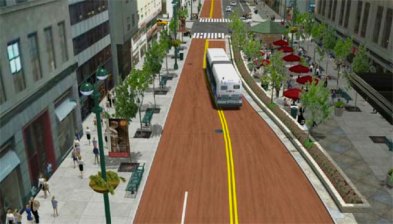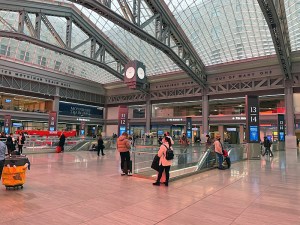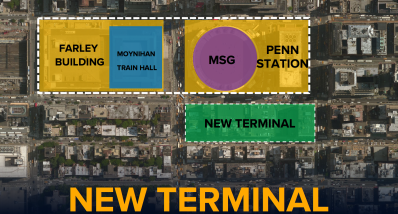Eyes on the Street: All Rise for the New Moynihan Train Hall (Because You Can’t SIT There!)

First, the good news: People who arrive to New York by intercity rail no longer experience the city like rats.
Beyond that, it’s difficult to say that taxpayers are exceptionally well served by $1.6 billion they just spent to convert a portion of the James A. Farley Building from postal service into an arrivals and departure hall for Amtrak and some Long Island Rail Road passengers.
For decades since the demolition of the original Pennsylvania Station, of course, those passengers were poorly served by that epochal building’s ne’er-do-well replacement: a series of rabbit warrens under Madison Square Garden that felt as if they were being crushed by the arena itself.
Where Penn Station is joyless and dark, Moynihan Hall, which opened for business on Friday, is triumphal and airy.
But spend a few hours poking around and you’ll see its flaws, shortcomings and shrug-inducing corners.
Entry notes
Visitors notice two things immediately: The grand steps, columns and monumental inscription (“Neither snow, nor rain…”) of the Farley Building have anything to do with the Moynihan Hall — visitors enter through small entrances on the corners of the building (photo below):

There is also no bike parking anywhere to be found, which is probably why people are making do (photo below):

There is also a new entrance to the existing mess under Madison Square Garden for Long Island Rail Road and New Jersey Transit passengers arriving from streets to the east of the new train hall (which really only serves Amtrak passengers or LIRR riders who need to finish their commutes to the west of the station).
For perspective, both South Station in Boston and Union Station in DC have had bike parking for over 12 years…
Even Los Angeles has a bike parking facility at their union station.
(Beautiful Union Station DC bike parking station pitctured below) pic.twitter.com/ACm9Ws32AH
— Shabazz Stuart (@ShabazzStuart) January 2, 2021
There’s also a new entrance to the old Penn Station (see photo below), which is important because if you go to Moynihan Hall looking for New Jersey Transit, you won’t easily find it (head down to the platforms and walk east to the old Penn Station, where NJ Transit remains in its cramped corner):

If you arrive as a passenger — i.e. from the tracks — not much will look very different until you get up stairs. The platforms — which are the same ones that run under Penn Station, too — have merely been cleaned a bit (but they’ve also been sullied with advertising everywhere, including for manscaping products; it’s a reminder that these days, we are never far from a blinking screen trying to sell us something).

It’s worth noting that $1.6 billion did not get New Yorkers any additional train capacity (that’s part of a future project), so Penn Station’s tracks continue to operate at 100 percent of capacity, though now there is more room for people to spread out.
The main hall itself
Whether you’ve arrived from the street or the platforms, the main hall is a great room, thanks to its dominant feature: large trusses holding up glass panels that allow Amtrak passengers the first dose of Vitamin D they’ve had in decades. Just as tourists visit Grand Central Terminal to gape at the ceiling, so too will visitors stand and admire Skidmore, Owings and Merrill’s work here.
At the center of the room is the other dominant accessory: A grand clock which is cheerfully analog (but also redundant, given that every passenger is likely checking arrival and departure times on his or her phone). The other main element of train stations worldwide — a large arrivals and departure board — is relegated to a dark corner for some reason. The singular joy of Penn Station was the clattering old Solari split-flap display board, which was replaced in 2000 by another central signboard, which itself was replaced by small TV screens in 2016.
It seems weird not to have a central gathering place to groan communally about late trains, but then, that’s not really the point of waiting for a train anymore, is it?
There are no seats for the public in Moynihan Hall and that’s because if people are sitting, they are not likely to be spending. Later this year (hopefully), a food hall will join the retail offerings, which are currently limited to a Starbucks and other nondescript geneticisms. All the corridors are filled with signs hyping what is to come.

But the lack of public seating is an outrage that public officials should be forced to defend … in public. It is true that the current Penn Station also lacks free seats (which explains why people are sitting all over the floor over there), but a better hall demands better amenities for the people who paid for it. And that ain’t just ticket buyers.
Public seating is what makes anything public space. Yes, retail adds life to some spaces, but there’s a difference between shopping malls and grand public edifices. That difference is seats.

The absence of seats is not some Amtrak thing — much smaller transit facilities in New Haven and Providence and other cities on the Amtrak map have places to sit whether you have a ticket or not. In Moynihan Hall, all the places to relax are the exclusive domain of the Haves, not the Have Nots. That goes for the seating area on the main floor — whose seats have built-in plugs and charging ports, and resemble those in a really nice Scandinavian airport — and for the lounge one level up. And it will also go for all of the retail space that won’t open until later this year; it’s likely you could sit there without buying anything, but it’s definitely not likely to be encouraged.
Grand Central Terminal does have seating downstairs in the food hall, but the seating is entirely public and you don’t have to buy a thing to use them. But the new train hall has one thing that Grand Central doesn’t have — clean bathrooms (though the new facility’s, um, facilities are off in a corner and not very big).
All of that said, it’s important to remember what the Moynihan Hall is replacing:

Who is this Moynihan guy anyway?
We would be remiss if we did not mourn two things about the hall’s namesake — albeit in contradictory fashion. If there is any tribute or monumental signage to Sen. Daniel Patrick Moynihan, who had the vision to turn the post office into a train station back in the early 1990s (when the budget was just $315 million), we didn’t see it.
And, frankly, that’s a good thing. While he remains beloved in many people’s memories, Moynihan’s thinly veiled racism would likely have kept his name off this ultimate urban project were it not for how relentlessly he pushed it. Moynihan’s comments before he became a senator, when he served Presidents Johnson and Nixon, caused intense pain among Black Americans and it’s not right to sweep such comments under the skylight of the new hall.
Alan Minor has been pointing to several of Moynihan’s most egregious work on Twitter (account is private), most notably, “The Negro Family,” his 1965 report.
— with Max Grinnell


